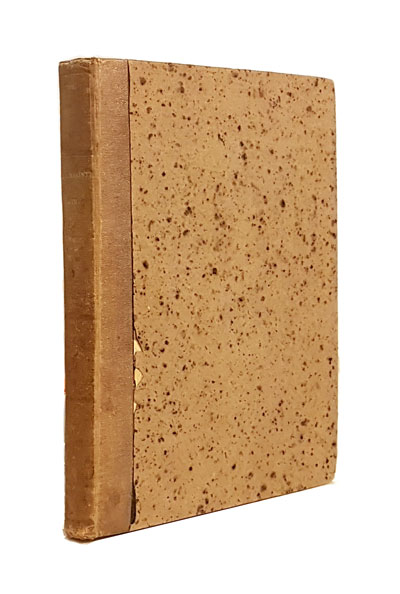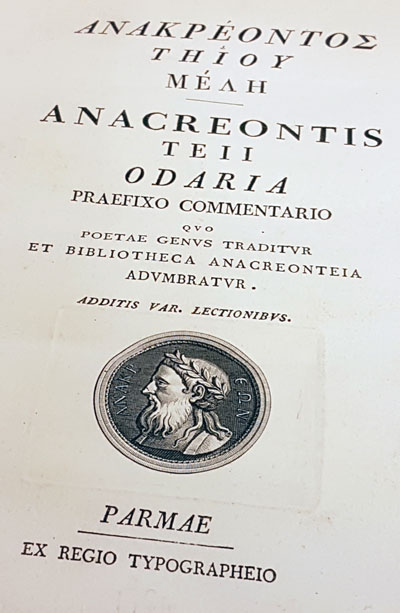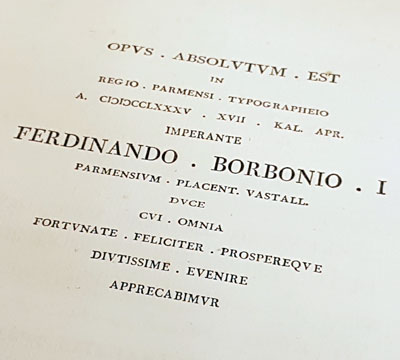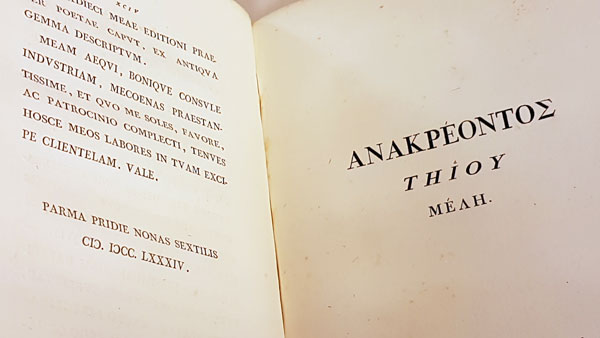About the printer:
Giambattista Bodoni (1740 – 1813) was an Italian typographer, type-designer, compositor, printer and publisher in Parma.
He first took the type-designs of Pierre Simon Fournier as his exemplars, but afterwards became an admirer of the more modelled types of John Baskerville; and he and Firmin Didot evolved a style of type called ‘New Face’, in which the letters are cut in such a way as to produce a strong contrast between the thick and thin parts of their body. Bodoni designed many type-faces, each one in a large range of type sizes. He is even more admired as a compositor than as a type-designer, as the large range of sizes which he cut enabled him to compose his pages with the greatest possible subtlety of spacing. Like Baskerville, he sets off his texts with wide margins and uses little or no illustrations or decorations.
There have been several modern revivals of his type-faces, all called Bodoni. They are often used as display faces.
About Anacreon:
Anacreon (/əˈnækriən/; Greek: Ἀνακρέων ὁ Τήϊος; c. 582 – c. 485 BC) was a Greek lyric poet, notable for his drinking songs and hymns. Later Greeks included him in the canonical list of nine lyric poets.
Anacreon was born at Teos, an Ionian city on the coast of Asia Minor. The name and identity of his father is a matter of dispute, with different authorities naming four possibilities: Scythianus, Eumelus, Parthenius, or Aristocritus.
It is likely that Anacreon fled into exile with most of his fellow-townsmen who sailed to Thrace when their homeland was attacked by the Persians. There they founded a colony at Abdera, rather than remaining behind to surrender their city to Harpagus, one of Cyrus the Great’s generals. Cyrus was, at the time (545 BC), besieging the Greek cities of Asia Minor. Anacreon seems to have taken part in the fighting, in which, by his own admission, he did not distinguish himself.
From Thrace he travelled to the court of Polycrates of Samos. He is said to have been a tutor of Polycrates; that he enjoyed the tyrant’s confidence is based on Herodotus, who observes that the poet was sitting in the royal chamber when an audience was given to the Persian herald. In return for his favour and protection, Anacreon wrote many complimentary odes about his patron. Like his fellow-lyric poet, Horace, who was one of his great admirers, and in many respects a kindred spirit, Anacreon seems to have been made for the society of courts.
On the death of Polycrates, Hipparchus, who was then in power at Athens and inherited the literary tastes of his father Peisistratus, sent a special embassy to fetch the popular poet to Athens in a galley of fifty oars. In Athens he became acquainted with the poet Simonides, and other members of the brilliant circle which had gathered around Hipparchus. When this circle was broken up by the assassination of Hipparchus, Anacreon seems to have returned to his native town of Teos, where, according to a metrical epitaph ascribed to his friend Simonides, he died and was buried.
According to others, before returning to Teos, he accompanied Simonides to the court of Echecrates, a Thessalian dynast of the house of the Aleuadae. Lucian mentions Anacreon amongst his instances of the longevity of eminent men, as having completed eighty-five years. If an anecdote given by Pliny the Elder is correct, he was choked at last by a grape-stone, but the story has an air of mythical adaptation to the poet’s habits, which makes it more likely to be apocryphal.
For a long time, Anacreon was popular in Athens, where his statue was to be seen on the Acropolis, together with that of his friend Xanthippus, the father of Pericles. On several coins from Teos he is represented holding a lyre in his hand, sometimes sitting, sometimes standing. A marble statue found in 1835 in the Sabine district, and now in the Galleria Borghese, is said to represent Anacreon.
Anacreon’s poetry touched on universal themes of love, infatuation, disappointment, revelry, parties, festivals, and the observations of everyday people and life. It is the subject matter of Anacreon’s poetry that helped to keep it familiar and enjoyable to generations of readers and listeners. His widespread popularity inspired countless imitators, which also kept his name alive.
Anacreon had a reputation as a composer of hymns, as well as of those bacchanalian and amatory lyrics which are commonly associated with his name. Two short hymns to Artemis and Dionysus, consisting of eight and eleven lines respectively, stand first amongst his few undisputed remains, as printed by recent editors. But hymns, especially when addressed to such deities as Aphrodite, Eros and Dionysus, are not so very unlike what we call “Anacreontic” poetry as to make the contrast of style as great as the word might seem to imply. The tone of Anacreon’s lyric effusions has probably led to an unjust estimate, by both ancients and moderns, of the poet’s personal character. The “triple worship” of the Muses, Wine and Love, ascribed to him as his religion in an old Greek epigram, may have been as purely professional in the two last cases as in the first, and his private character on such points was probably neither much better nor worse than that of his contemporaries. Athenaeus remarks acutely that he seems at least to have been sober when he wrote. His character was an issue, because, according to Pausanias, his statue on the Acropolis of Athens depicts him as drunk. He himself strongly repudiates, as Horace does, the brutal characteristics of intoxication as fit only for barbarians and Scythians.
Of the five books of lyrical pieces by Anacreon which the Suda and Athenaeus mention as extant in their time, we have now but the merest fragments, collected from the citations of later writers.
A collection of poems by numerous, anonymous imitators was long believed to be the works of Anacreon himself. Known as the Anacreontea, it was preserved in a 10th-century manuscript which also included the Palatine Anthology. The poems were published in 1554 with a Latin translation by Henry Estienne, known as Stephanus, but little is known about the origins of the manuscript. Salmasius reports seeing the Anacreontea at the library in Heidelberg in 1607. In 1623, it was given to Pope Gregory XV after the sacking of Heidelberg. It was later taken from the Vatican City by Napoleon in 1797, who had it rebound as two separate volumes. One of those volumes was returned to Heidelberg but the other remained in the Bibliothèque Nationale in Paris.
In the 17th century, Thomas Stanley translated the Anacreontea into English verse. A few poems were also translated by Robert Herrick and Abraham Cowley. The poems themselves appear to have been composed over a long period of time, from the time of Alexander the Great until the time that paganism gave way in the Roman Empire. They reflect the light hearted elegance of much of Anacreon’s genuine works although they were not written in the same Ionic Greek dialect that Anacreon used. They also display literary references and styles more common to the time of their actual composition.
More at wikipedia.





